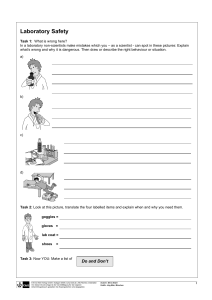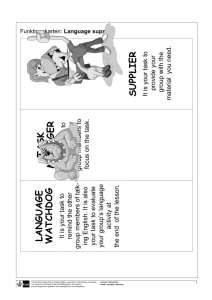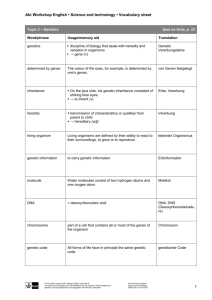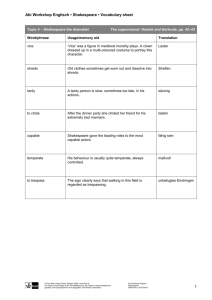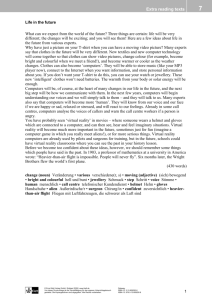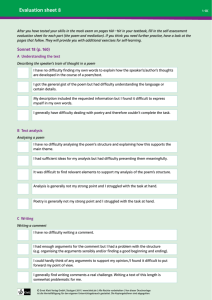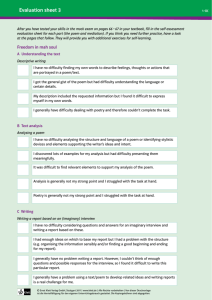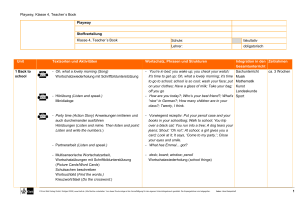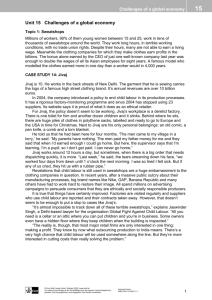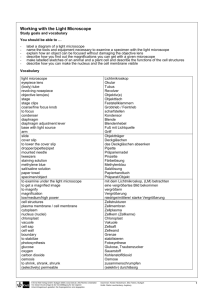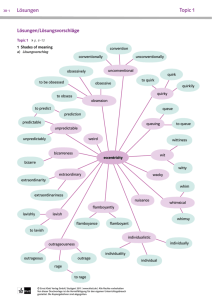Text analysis: D Visual texts
advertisement
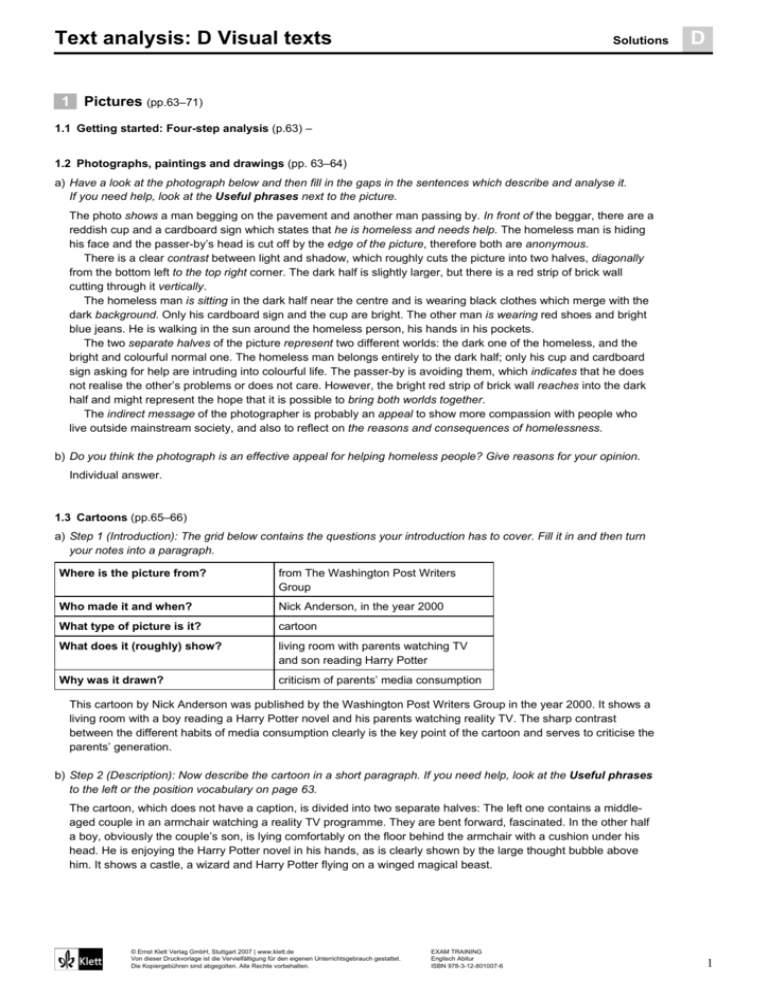
Text analysis: D Visual texts Solutions D 1 Pictures (pp.63–71) 1.1 Getting started: Four-step analysis (p.63) – 1.2 Photographs, paintings and drawings (pp. 63–64) a) Have a look at the photograph below and then fill in the gaps in the sentences which describe and analyse it. If you need help, look at the Useful phrases next to the picture. The photo shows a man begging on the pavement and another man passing by. In front of the beggar, there are a reddish cup and a cardboard sign which states that he is homeless and needs help. The homeless man is hiding his face and the passer-by’s head is cut off by the edge of the picture, therefore both are anonymous. There is a clear contrast between light and shadow, which roughly cuts the picture into two halves, diagonally from the bottom left to the top right corner. The dark half is slightly larger, but there is a red strip of brick wall cutting through it vertically. The homeless man is sitting in the dark half near the centre and is wearing black clothes which merge with the dark background. Only his cardboard sign and the cup are bright. The other man is wearing red shoes and bright blue jeans. He is walking in the sun around the homeless person, his hands in his pockets. The two separate halves of the picture represent two different worlds: the dark one of the homeless, and the bright and colourful normal one. The homeless man belongs entirely to the dark half; only his cup and cardboard sign asking for help are intruding into colourful life. The passer-by is avoiding them, which indicates that he does not realise the other’s problems or does not care. However, the bright red strip of brick wall reaches into the dark half and might represent the hope that it is possible to bring both worlds together. The indirect message of the photographer is probably an appeal to show more compassion with people who live outside mainstream society, and also to reflect on the reasons and consequences of homelessness. b) Do you think the photograph is an effective appeal for helping homeless people? Give reasons for your opinion. Individual answer. 1.3 Cartoons (pp.65–66) a) Step 1 (Introduction): The grid below contains the questions your introduction has to cover. Fill it in and then turn your notes into a paragraph. Where is the picture from? from The Washington Post Writers Group Who made it and when? Nick Anderson, in the year 2000 What type of picture is it? cartoon What does it (roughly) show? living room with parents watching TV and son reading Harry Potter Why was it drawn? criticism of parents’ media consumption This cartoon by Nick Anderson was published by the Washington Post Writers Group in the year 2000. It shows a living room with a boy reading a Harry Potter novel and his parents watching reality TV. The sharp contrast between the different habits of media consumption clearly is the key point of the cartoon and serves to criticise the parents’ generation. b) Step 2 (Description): Now describe the cartoon in a short paragraph. If you need help, look at the Useful phrases to the left or the position vocabulary on page 63. The cartoon, which does not have a caption, is divided into two separate halves: The left one contains a middleaged couple in an armchair watching a reality TV programme. They are bent forward, fascinated. In the other half a boy, obviously the couple’s son, is lying comfortably on the floor behind the armchair with a cushion under his head. He is enjoying the Harry Potter novel in his hands, as is clearly shown by the large thought bubble above him. It shows a castle, a wizard and Harry Potter flying on a winged magical beast. © Ernst Klett Verlag GmbH, Stuttgart 2007 | www.klett.de Von dieser Druckvorlage ist die Vervielfältigung für den eigenen Unterrichtsgebrauch gestattet. Die Kopiergebühren sind abgegolten. Alle Rechte vorbehalten. EXAM TRAINING Englisch Abitur ISBN 978-3-12-801007-6 1 Text analysis: D Visual texts Solutions D c) Step 3 (Analysis): Examine the elements in their relationships and functions. Which message do they convey? Pay special attention to the characters! The two halves are completely different. The parents’ half is relatively empty, with a bare wall and a huge TV set, whereas the boy’s half is crowded with the fantasy pictures in the thought bubble. The parents look as if they were drugged or hypnotised. Their son, on the other hand, looks more normal and relaxed. This contrast illustrates that reading is much richer and healthier than watching reality TV and thus criticises the behaviour of the parents. d) Step 4 (Evaluation): Do you agree with this evaluation of the cartoon? Discuss. Individual answer. © Ernst Klett Verlag GmbH, Stuttgart 2007 | www.klett.de Von dieser Druckvorlage ist die Vervielfältigung für den eigenen Unterrichtsgebrauch gestattet. Die Kopiergebühren sind abgegolten. Alle Rechte vorbehalten. EXAM TRAINING Englisch Abitur ISBN 978-3-12-801007-6 2 Text analysis: D Visual texts Solutions D 2 Tables, graphs and charts (pp.67–71) 2.1. Getting started: Definitions (p.67) a) Here are examples of the four most common visualisations together with their names. Read the definitions and functions in the grid below and then fill in the correct visualisations and their names. Visualisation Name Definition Function table • a grid with numbers systematically arranged in lines and columns • gives raw data as a basis for analysis (line) graph • one or more lines in a system of coordinates with two axes – a horizontal and a vertical one • shows the development of sth over a period of time (tendencies and trends) bar chart • boxes of different height/length in a system of coordinates with two axes – a horizontal and a vertical one • shows differences between various things pie chart • is a circle divided into different sections • shows the percentages of a whole © Ernst Klett Verlag GmbH, Stuttgart 2007 | www.klett.de Von dieser Druckvorlage ist die Vervielfältigung für den eigenen Unterrichtsgebrauch gestattet. Die Kopiergebühren sind abgegolten. Alle Rechte vorbehalten. EXAM TRAINING Englisch Abitur ISBN 978-3-12-801007-6 3 Text analysis: D Visual texts Solutions D 2.2 Tables (p.68) a) Look at the table above and answer the six introduction questions in the grid. Introduction What is its topic? attitudes towards the spread of American ideas and customs in five foreign countries What type of presentation has been chosen? a table with three lines and six columns What is its source? (a newspaper, a survey of an organisation, etc.) The Economist (a weekly newspaper) What is its time of publication? 4th January 2003 What period of time is covered or what point of time does it refer to? not known What figures are presented, numbers (e.g. 456) or percentage figures (e.g. 26.8%)? percentage figures b) Describe the table “Suspicious minds”: How many Britons/Germans/Poles/Turks/Japanese think that …? Turn each percentage figure into words and write them into the grid, using the expressions below. Half of the Britons … Over two thirds of the Germans … More than half of the Poles … The overwhelming majority of Turks … A third of the Japanese … … think the spread of American ideas and customs is a bad thing. Two out of five Britons … More than one third of the Germans … Roughly one out of four Poles … A third of the Turks … Three out of five Japanese … … think that when differences occur with America, it is because of their country’s different values. © Ernst Klett Verlag GmbH, Stuttgart 2007 | www.klett.de Von dieser Druckvorlage ist die Vervielfältigung für den eigenen Unterrichtsgebrauch gestattet. Die Kopiergebühren sind abgegolten. Alle Rechte vorbehalten. EXAM TRAINING Englisch Abitur ISBN 978-3-12-801007-6 4 Text analysis: D Visual texts 2.3 Solutions D Graphs (p.69) a) For describing graphs, you need to be able to put lines into words. Read the phrases below carefully and look up those which you do not know. – b) Have a close look at the line graph to the right. Fill in the gaps in the following text, which answers the six introduction questions from the page before. The title of the line graph on the right is “Outsiders’ plight”. It refers to its topic, i.e. the development of long-term unemployment in six industrial countries. The graph was published on 11th February 2006 in The Economist. Six lines in a single system of coordinates, one for each country, cover the period from 1980 to 2000 in four steps of five years and then the remaining four years up to the year 2004. The figures presented on the vertical axis are the percentage figures of the long-term unemployed as part of the total unemployment. c) Study the lines in the graph above in detail. Add the missing countries and the descriptions for the United States and Italy in the grid below. Describing a development Long-term unemployment in Since 1985, the percentages of long-term unemployment in these two countries have developed very differently. Whereas in one country the figure has steadily increased from a low level, the other one of the two has experienced a continual decline in its figure. Japan Britain United States Between 1980 and 1985, the percentage of long-term unemployed rose, but then fell again during the next five years. After that it stayed almost the same until about 2001, when it began to increase again. At all times, the percentage figure of long-term unemployment was below those of the other four countries. From 1980 to 1990, the percentage of long-term unemployed remained almost constant, then it steadily increased for a long time until about 2001. Then there was a sudden drop followed by a noticeable increase from 2002 onwards. Germany From 1985, the percentage of long-term unemployment grew gradually until it reached a peak of 70% in the year 1990. From then on, it fell consistently to a low of 50% in 2004. Until 2001 this decrease happened at a relatively low and steady rate, but then it accelerated significantly. Italy © Ernst Klett Verlag GmbH, Stuttgart 2007 | www.klett.de Von dieser Druckvorlage ist die Vervielfältigung für den eigenen Unterrichtsgebrauch gestattet. Die Kopiergebühren sind abgegolten. Alle Rechte vorbehalten. EXAM TRAINING Englisch Abitur ISBN 978-3-12-801007-6 5 Text analysis: D Visual texts Solutions D 2.4 Charts (pp.70–71) a) Look at the pie chart below. It is taken from a (fictitious) market research about the amount of money people spend on magazines. Describe it with the help of the Useful phrases in the box on the left. The pie chart visualises how much money is spent on magazines per month. The whole circle is divided into four segments which represent certain categories. The largest of these categories consists of those who spend less than two dollars per month: 36.5%. The second largest section (32%) shows those who spend between two and five dollars. The people who spend between five and ten Dollars still make up a respectable 23.5%. However, only a minority of 8% of the people spend even more than that. b) Now look at the bar chart on the left and read the Useful phrases below. Compare the countries in a short paragraph. Switzerland has the highest rating for subjective well-being, followed by the USA. Britain, the western states of Germany and France come next, with very similar results. A group consisting of Spain, Italy, Japan and the eastern states of Germany has almost identical figures, slightly below the average of the chart. People feel the least happy in Poland and Turkey, both of which have by far the lowest scores. Maybe the most interesting aspect of this chart is the discrepancy between the eastern and western states of Germany: in spite of belonging to the same country, people feel significantly happier in the West. c) Below there are suggestions about if and how you could present the information from “Could be worse” in other ways. Think about the advantages or disadvantages of each type of visual and fill in the empty boxes in the grid. “Could be worse” as a … Possible? table line graph pie chart bar chart yes only with additional figures over a period of time; no, you would need percentages, for example on how many people in France would say they are “very satisfied” with their lives, how many are “mostly satisfied”, etc.; yes the different countries could be represented by lines in different colours then you could make a separate pie chart for each country Advantages/ disadvantages can include more raw information than the others; can show a development over a period of time exact; visually boring © Ernst Klett Verlag GmbH, Stuttgart 2007 | www.klett.de Von dieser Druckvorlage ist die Vervielfältigung für den eigenen Unterrichtsgebrauch gestattet. Die Kopiergebühren sind abgegolten. Alle Rechte vorbehalten. you can see the you can see the relation between the relation between the numbers at one glance; numbers at one glance; colourful and visually appealing, but cannot show fine differences very well EXAM TRAINING Englisch Abitur ISBN 978-3-12-801007-6 flexible: can show percentages or absolute figures 6
